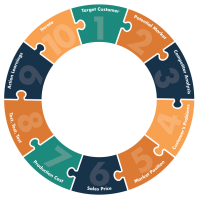Identify your competitive advantage

Your competitive advantage is what makes customers come to YOU, rather than your rivals. You know you want one. So how do you work out what it is?
To identify your competitive advantage, you need to work backwards. Your product is a solution for your customers – they buy it because they have a need or a problem. So what problem are you solving? And for whom?
Problem Solving
Let’s look at how you identify your customers’ needs, using a very successful business example – Dyson vacuum cleaners, back in the 1990s.
Your customer wants clean floors. This is the basic need or problem you are addressing. Vacuum cleaners already exist – cast your mind back, these were the ‘90s, when each vacuum cleaner had to have a bag inside. There were a number of ‘problems’ associated with vacuum cleaners with bags. The bags filled up and needed to be changed regularly. This led to problems of running out of bags, repeat costs of purchasing spare bags, mess if the bags split, impossible to retrieve something sucked up in error (without slicing open the bag) and, Dyson’s main hate, the filters clogged up and the suction efficiency dropped.
Whose problem is it?
Once you’ve identified the problems you are aiming to solve, you need to figure out who cares enough to buy the solution.
Who cleans the house? It might be a resident or a hired cleaner. There’s a big difference here, which you need to consider. A cleaner is your consumer – they are the one using your product. The owner of the house is the person who bought the vacuum cleaner – they are your customer. The owner may also be the user/ consumer. But crucially, you need to recognise that the customer is the one who buys your goods, and that they may not be the end user.
You need to be selling to the customer and addressing the issues they recognise.
The problems identified above don’t all apply to the customer. If they are not the one changing the bag, why would they care about the mess and the hassle?
The house owner / customer is likely to care about having a properly clean house – after all, they’ve bothered to buy a vacuum cleaner and possibly hire a cleaner. So the impact of the suction power will be important to them, as this impacts the product performance. Removing any repeat costs (such as bag purchases) is also appealing for to the customer’s wallet.
So how did Dyson gain the competitive advantage and become the leader in the vacuum cleaning market?
Dyson cleaners had new cyclone technology, reducing clogged filters (tick on suction power and cleanliness). They were bagless and easy to use (tick on hassle and repeat purchases). They had all the functionality of a traditional vacuum cleaner, AND MORE. The suction, cleanliness and ease of use made Dyson a desirable product, and it rapidly developed an aura of prestige, having a Dyson had a social cachet against it. The higher price point charged for a Dyson was not a barrier to high sales, due to the enhanced performance and brand status.
Dyson identified a problem, created a solution and cornered the market by addressing needs his competitors had overlooked.
When you are defining your competitive advantage, you need to dig down to identify the problems you are solving, and to make sure they are the problems faced by your target customer. If you can do this, you have taken a major step towards business success.
Ironically, despite Dyson’s domination of the vacuum cleaner market, we still refer to them as ‘hoovers’.






